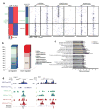Genetic inactivation of the polycomb repressive complex 2 in T cell acute lymphoblastic leukemia
- PMID: 22237151
- PMCID: PMC3274628
- DOI: 10.1038/nm.2651
Genetic inactivation of the polycomb repressive complex 2 in T cell acute lymphoblastic leukemia
Abstract
T cell acute lymphoblastic leukemia (T-ALL) is an immature hematopoietic malignancy driven mainly by oncogenic activation of NOTCH1 signaling. In this study we report the presence of loss-of-function mutations and deletions of the EZH2 and SUZ12 genes, which encode crucial components of the Polycomb repressive complex 2 (PRC2), in 25% of T-ALLs. To further study the role of PRC2 in T-ALL, we used NOTCH1-dependent mouse models of the disease, as well as human T-ALL samples, and combined locus-specific and global analysis of NOTCH1-driven epigenetic changes. These studies demonstrated that activation of NOTCH1 specifically induces loss of the repressive mark Lys27 trimethylation of histone 3 (H3K27me3) by antagonizing the activity of PRC2. These studies suggest a tumor suppressor role for PRC2 in human leukemia and suggest a hitherto unrecognized dynamic interplay between oncogenic NOTCH1 and PRC2 function for the regulation of gene expression and cell transformation.
Figures




References
-
- Orlando V. Polycomb, epigenomes, and control of cell identity. Cell. 2003;112:599–606. - PubMed
-
- Barski A, et al. High-resolution profiling of histone methylations in the human genome. Cell. 2007;129:823–837. - PubMed
-
- Aifantis I, Raetz E, Buonamici S. Molecular pathogenesis of T-cell leukaemia and lymphoma. Nat Rev Immunol. 2008;8:380–390. - PubMed
Publication types
MeSH terms
Substances
Associated data
- Actions
- Actions
Grants and funding
- U54-AI057158/AI/NIAID NIH HHS/United States
- P30 CA016087/CA/NCI NIH HHS/United States
- R01 CA133379/CA/NCI NIH HHS/United States
- R01CA133379/CA/NCI NIH HHS/United States
- 5P30CA16087/CA/NCI NIH HHS/United States
- R01 CA149655/CA/NCI NIH HHS/United States
- R01 CA105129/CA/NCI NIH HHS/United States
- U54 AI057158/AI/NIAID NIH HHS/United States
- R01GM088847/GM/NIGMS NIH HHS/United States
- R21 CA141399/CA/NCI NIH HHS/United States
- R01 CA120196/CA/NCI NIH HHS/United States
- R01CA155743/CA/NCI NIH HHS/United States
- R01CA105129/CA/NCI NIH HHS/United States
- 5P30CA16087-31/CA/NCI NIH HHS/United States
- R21CA141399/CA/NCI NIH HHS/United States
- HHMI/Howard Hughes Medical Institute/United States
- R01CA120196/CA/NCI NIH HHS/United States
- R01CA149655/CA/NCI NIH HHS/United States
- 1R01LM010140-01/LM/NLM NIH HHS/United States
- U24 CA114737/CA/NCI NIH HHS/United States
- R01 LM010140/LM/NLM NIH HHS/United States
- R01 GM088847/GM/NIGMS NIH HHS/United States
- R01 CA155743/CA/NCI NIH HHS/United States
LinkOut - more resources
Full Text Sources
Other Literature Sources
Molecular Biology Databases

